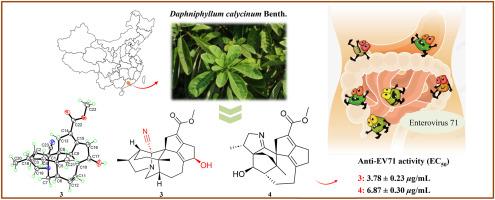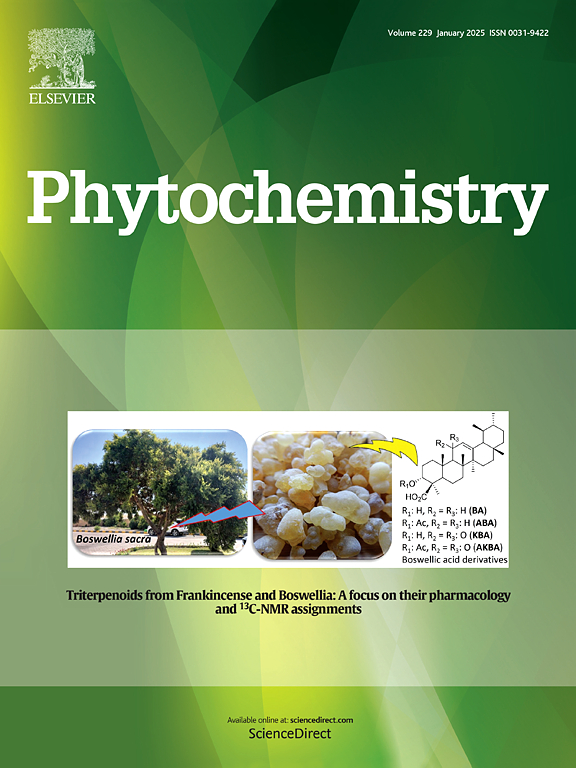从水蚤叶和茎中提取具有抗肠道病毒活性的含氰水蚤生物碱
IF 3.4
2区 生物学
Q2 BIOCHEMISTRY & MOLECULAR BIOLOGY
引用次数: 0
摘要
肠病毒71型(EV71)是手足口病(手足口病)的主要病原体,通常与严重的临床结果相关。本研究从药用植物水蚤(Daphniphyllum calycinum Benth)的叶和茎中分离得到了三种罕见的含氰生物碱cyanodaphcalycines A-C(1-3)和一种未被描述的水蚤素a型生物碱水蚤素G(4)。,以及三种已知的水蚤生物碱(5-7)。之前描述的结构及其绝对构型是通过光谱分析、单晶x射线衍射分析和随时间密度泛函理论-电子圆二色性(TDDFT-ECD)计算相结合确定的。在生物学评价方面,测定了化合物1 ~ 4对人恶性胚胎横纹肌肉瘤(RD)细胞EV71的抗病毒活性。化合物3和4在RD细胞中对人EV71病毒具有较强的抗病毒作用,EC50值分别为3.78±0.23和6.87±0.30 μg/mL,优于利巴韦林(EC50值为65.77±0.11 μg/mL)。这是水蚤生物碱作为EV71有效抑制剂的首次报道。本文章由计算机程序翻译,如有差异,请以英文原文为准。

Cyano-containing Daphniphyllum alkaloids with antienteroviral activity from the leaves and stems of Daphniphyllum calycinum Benth
Enterovirus 71 (EV71), a major causative agent of hand, foot, and mouth disease (HFMD), is often associated with severe clinical outcomes. In this study, three rare cyano-containing alkaloids, cyanodaphcalycines A–C (1–3), featuring an unusual 5/6/6/7/5/5-hexacyclic scaffold, and an undescribed daphmanidin A-type alkaloid, daphmanidin G (4), were isolated from the leaves and stems of the medicinal plant Daphniphyllum calycinum Benth., along with three known Daphniphyllum alkaloids (5–7). The previously undescribed structures and their absolute configurations were determined using a combination of spectroscopic analysis, a single crystal X-ray diffraction analysis, and time-dependent density functional theory-electronic circular dichroism (TDDFT-ECD) calculations. In the biological evaluation, the antiviral activities of compounds 1–4 were tested against EV71 in human malignant embryonal rhabdomyosarcoma (RD) cells. Compounds 3 and 4 exhibited potent antiviral effects against human EV71 in RD cells, with EC50 values of 3.78 ± 0.23 and 6.87 ± 0.30 μg/mL, respectively, demonstrating superior efficacy to ribavirin (EC50 65.77 ± 0.11 μg/mL). This is the first report of Daphniphyllum alkaloids as potent inhibitors of EV71.
求助全文
通过发布文献求助,成功后即可免费获取论文全文。
去求助
来源期刊

Phytochemistry
生物-植物科学
CiteScore
6.40
自引率
7.90%
发文量
443
审稿时长
39 days
期刊介绍:
Phytochemistry is a leading international journal publishing studies of plant chemistry, biochemistry, molecular biology and genetics, structure and bioactivities of phytochemicals, including ''-omics'' and bioinformatics/computational biology approaches. Phytochemistry is a primary source for papers dealing with phytochemicals, especially reports concerning their biosynthesis, regulation, and biological properties both in planta and as bioactive principles. Articles are published online as soon as possible as Articles-in-Press and in 12 volumes per year. Occasional topic-focussed special issues are published composed of papers from invited authors.
 求助内容:
求助内容: 应助结果提醒方式:
应助结果提醒方式:


